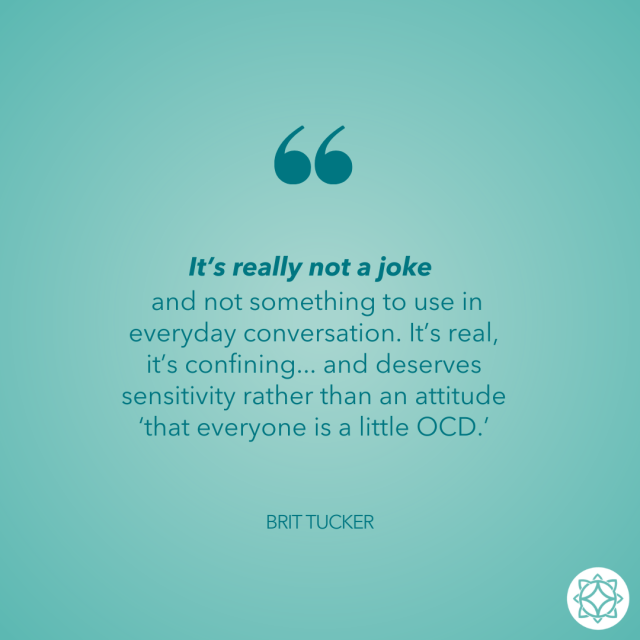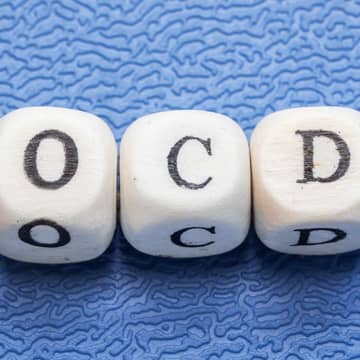
We've all heard people casually toss around phrases like "I'm so OCD" to explain their cleanliness preferences or reasons for liking things arranged a certain way.
But here's the deal: Obsessive-compulsive disorder (OCD) isn't a justification (or a punchline) for our everyday habits. It's a real, serious and often debilitating mental health condition.
The 4 types of OCD
Experts agree that the four main types of OCD are:
- Harm obsession
- Perfection/symmetry obsession
- Contamination/cleanliness obsession
- Hoarding
Keep reading to learn more about the four types of OCD.

What is OCD?
Obsessive-compulsive disorder is characterized by uncontrollable, repetitive thoughts (called obsessions) that just won't let you be.
To make obsessive thoughts disappear, you may engage in specific actions (called compulsions) repeatedly and so often that the obsessions and compulsions start impacting your daily life.
What does OCD feel like?
Imagine that your mind keeps asking "what if" questions and the only way to cope is by doing repetitive actions.
- What if I don’t quadruple-check the oven, ensuring it’s off?
- What if I didn’t wash my hands enough and I've already infected everyone in my family with a deadly disease?
It's all about finding certainty and avoiding those nagging doubts that keep popping up[1].
Ellen Brandenburg, LCSW-C (she/her) points out that the media often focuses on portraying just one specific type of OCD, which can result in many cases of OCD going unnoticed.

The 4 types of OCD explained
Although there are various types of OCD, the four most common types are characterized as follows:
1. Harm obsession
Imagine constantly grappling with the fear that you might cause harm to yourself or others, even though you have no true intention or desire to do so. This is what people with harm obsession experience. They fear acting on violent urges, including self-harm or hurting someone else unintentionally. To relieve this distress, they may engage in compulsions like avoiding sharp objects, repeatedly checking to ensure they haven't harmed anyone, or repeatedly asking others if they've caused any harm.
2. Perfection/symmetry obsession
Do you ever feel that something is just not quite right? For those with perfection/symmetry obsession, this feeling becomes all-consuming. They fixate on the idea that something is off-balance and strive for perfection and symmetry in their actions or surroundings. Compulsions often involve repeating steps until they feel "just right" or meticulously ordering, aligning and organizing things that seem out of order.
3. Contamination/cleanliness obsession
Imagine being constantly afraid of germs, fluids, and touching items that might be contaminated. This is what contamination/cleanliness obsession feels like. Individuals with this subtype fear spreading contaminants and may go to great lengths to avoid them. Compulsions include repeated handwashing, extensive bathing routines, and avoiding public places and physical contact with people.
4. Hoarding
This looks like holding onto things others might consider unimportant, like old magazines, clothes or notes. Over time, these things pile up, making one’s home look cluttered and messy. People who tend to hoard often worry about losing these items, thinking they might come in handy someday. Such folks can become very attached to their stuff. People with hoarding tendencies might also experience high levels of anxiety or sadness, and may have difficulty holding down a steady job.

Other types of OCD
Beyond these 4 main types, there are other versions of OCD.
"False memory” OCD
This type is characterized by frequent doubts about unintentional actions, such as worrying about stealing or not paying for items. This leads to a great deal of distress.
"Magical thinking” OCD
This type encompasses irrational or superstitious beliefs. The individual thinks that not performing certain actions will result in unrelated catastrophic events, and this belief consumes their thoughts and behaviors.
Note: These subtypes can also overlap with the four main subtypes discussed above.
Each type of OCD brings its own unique challenges. And there are, debatably, even more OCD subtypes out there. Research on OCD is constantly expanding our knowledge and understanding[2].

Can you have multiple types of OCD?
"When someone has the diagnosis of OCD, it is highly possible to have the presentation of multiple types of obsessions and/or multiple compulsions," says Brandenburg. "Anecdotally, it has been my experience that my clients often have more than one obsession or more than one compulsive behavior, and oftentimes both."
So, in short: yes, one can present with multiple forms or expressions of OCD.
In these complex cases, the approach to treatment should be flexible. Brandenburg highlights that the success of treatment depends on:
- How motivated the person is to engage in treatment
- Finding the most effective therapeutic approach (and, for some, medication) for their unique case
As a clinician, Brandenburg faces the challenge of finding the right balance between managing obsessions and compulsions and figuring out how to get early wins in therapy.
Brandenburg genuinely understands that people with OCD often go through a lot of pain and distress, which is why it's a good idea to start where they can make some quick progress to get them fully committed and hopeful in their healing.
In addition to competing obsessions and compulsions, an OCD diagnosis could come with a comorbid condition, such as depression or anxiety.
These parallel disorders, along with society’s misunderstanding of OCD, can make its identification and diagnosis a particularly tricky task[3].
OCD therapy
Effective treatment of OCD often involves different therapeutic approaches designed to reduce the impact of obsessions and compulsions on your life.
Following are some key therapies that specifically work in OCD treatment.
Cognitive behavioral therapy (CBT):
- Cognitive change methods. CBT can help you learn how to untangle your thoughts, like figuring out a tricky puzzle. It helps you see how your thoughts can play with your emotions. You'll find ways to spot and gently tweak those thoughts that bring you stress and anxiety.
- Behavior change methods. CBT helps you change how you respond to different situations. It's a bit like breaking a habit – learning new, more helpful ways to handle things when OCD tries to sneak in.
Exposure and response prevention (ERP):
- ERP is an evidence-based method that teaches you how to take small steps to conquer your fears. You are gently introduced to the things that make you anxious, one manageable bit at a time. It's all about helping you become more comfortable with what triggers your obsessions.
- Trained therapists act as friendly guides on the ERP journey. They'll be there, step by step, helping you cope with the emotions that come up to help you improve your day-to-day functioning.
OCD case study: Our patient’s story
Brandenburg shared a real-life story demonstrating the power of a whole-person approach to treating OCD and the importance of thinking outside the box when progress seems elusive.
One of her teenaged patients had been wrestling with contamination-based OCD for two years. She had initially sought help from a therapist practicing ERP but the results were disappointing. The patient’s daily life was dominated by compulsions, especially excessive cleaning and washing. She was spending over two hours in the bathroom, making her late for school and creating stressful friction around the shared bathroom.
After entering our program, Brandenburg led a family therapy session that changed everything. The teen expressed her desire to get better, but she also expressed feeling alone on her treatment journey and during the exposure exercises she’d been practicing. Her parents had a lightbulb moment, too; they realized their well-intentioned efforts to ease her anxiety had actually been accommodating her OCD.
From there, things picked up speed. Rooted in ERP, Brandenburg built an exposure hierarchy and got the parents involved in exposure exercises – turning off faucets, managing bathroom supplies, you name it. She even introduced a victory journal to celebrate progress and maintain momentum.
As treatment continued, exposure exercises became more frequent and intense. Our team offered feedback on accommodating behaviors and helped the family fine-tune their dialogue to better support the teen's progress. In less than two months, her time spent on compulsive behaviors dropped, taking her bathroom visits from over two hours to under 15 minutes.
But the transformation didn't stop there. The teen's anxiety about her obsessions also dwindled, allowing her to feel more confident about returning to school, embrace activities she genuinely enjoyed and spend more time with friends.
By the end of treatment, this resilient teen had become an advocate for family involvement and showed that even seemingly impossible exposure exercises can be conquered with the right support. Most importantly, her anxiety related to her obsessions became manageable, opening up a world of new opportunities.
See how Pathlight uses ERP to treat OCD.
OCD treatment at Pathlight
When it comes to treating OCD, we know there's no one-size-fits-all solution. But if you're looking for support and hope on your journey to recovery, consider what Pathlight Mood & Anxiety Center (Pathlight) has to offer through our residential, partial hospitalization and intensive outpatient programs:
- Proven treatments. Among other evidence-based treatments for OCD, we use ERP therapy to help you feel more at ease.
- Therapy that fits your needs. We provide one-on-one and group therapy sessions specially devised to work on OCD.
- Your family matters. We believe family plays a vital role in your journey. That's why we offer family therapy to ensure ongoing support and education.
- Guidance from caring experts. You'll be guided by our compassionate care team dedicated to helping you find healing. With their support, you can take steady and meaningful steps in managing your OCD and related anxiety concerns.
These therapeutic methods, including CBT, ERP and the specialized OCD treatments offered at Pathlight, give people with OCD the tools and support they need to manage their symptoms and reduce distress effectively. The choice of therapy often depends on an individual’s specific needs and the severity of their OCD symptoms.
Wondering whether you have OCD? Take this quiz.
Does some of this sound familiar, making you wonder whether you or a loved one might have OCD? Take our simple quiz to get a better idea. OCD is more common than you might think, and understanding it can help you or a loved one.
OCD resources
- If you or someone you know is dealing with OCD and in need of support and connection with others who “get it,” consider joining an OCD support group.
- If you want to dive deeper into OCD and hear real stories from people who've been there -- or are there now -- check out two episodes of the Mental Note podcast OCD With Mimi Cole and More Than My OCD - Moving Beyond Compulsion. These episodes shed light on what it's like to live with OCD and offer valuable insights. Click the links to listen and gain a better understanding of this condition.





